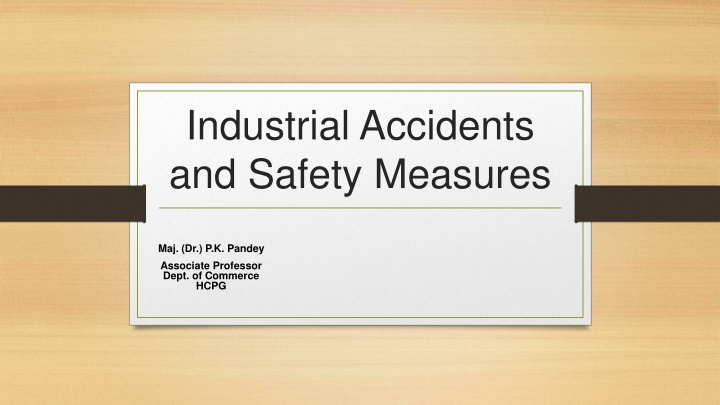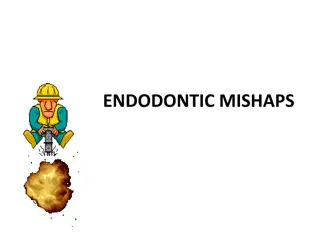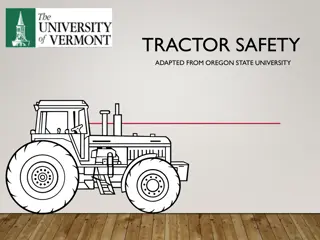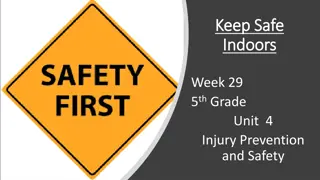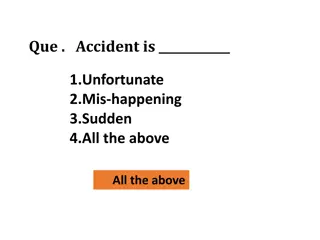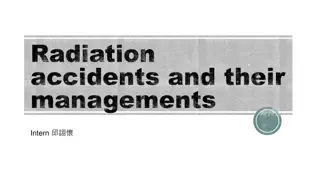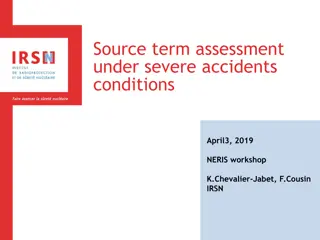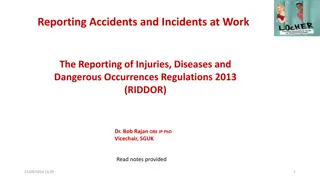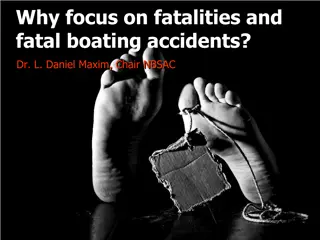Industrial Accidents and Safety Measures: Importance and Implementation
Industrial accidents pose significant risks to workers and property in industrial settings, often resulting from unsafe acts or conditions. Proper safety measures, including training, equipment selection, and vigilant supervision, can help prevent such accidents. Safety policies, health, and safety programs, and the use of personal protective equipment play crucial roles in ensuring a safe work environment and reducing the occurrence of accidents. By addressing root causes and promoting a safety culture, organizations can protect the well-being of their employees and foster a culture of workplace safety.
Download Presentation

Please find below an Image/Link to download the presentation.
The content on the website is provided AS IS for your information and personal use only. It may not be sold, licensed, or shared on other websites without obtaining consent from the author.If you encounter any issues during the download, it is possible that the publisher has removed the file from their server.
You are allowed to download the files provided on this website for personal or commercial use, subject to the condition that they are used lawfully. All files are the property of their respective owners.
The content on the website is provided AS IS for your information and personal use only. It may not be sold, licensed, or shared on other websites without obtaining consent from the author.
E N D
Presentation Transcript
Industrial Accidents and Safety Measures Maj. (Dr.) P.K. Pandey Associate Professor Dept. of Commerce HCPG
INDUSTRIAL ACCIDENTS: Definition: It is defined as an occurrence which interrupts or interferes with the orderly progress of work by causing injuries to people and damage to property in an industrial establishment. It is generally due to failure to follow proper procedures, following shortcuts, improper handling of materials, misuse of equipment , fatigue and over-confidence about abilities. These accidents also occur when thorough training and emphasis on safety techniques and procedures are not accentuated and reiterated through vigilant supervision. Some of the common types of industrial accidents are following: Slip & falls: Workers should be equipped with non-slip footwear and proper safety training to avoid resulting injuries such as musculoskeletal pain. Falling Objects: Injuries from falling objects occurred when it is improperly positioned. Proper training of positioning and transfer of such objects should be given to the employees who are involved Chemical burns/exposure: Chemical burns may occur by improper handling of chemicals or due to improper labelling resulted in injury to the personnel
Unsafe acts or conditions can be reduced in the following ways: Appropriate selection and placement of equipment, procedures applicable to particular job in an industry. Appropriate training to the personnel related to the job should be given prior to start of any activity to ensure that everyone clearly understands their role and risk involved Incentive programmes to promote safe act and culture in an industry Establishing safety policies and safety goals which will guide and motivate all the employees in an organisation to work safely Vigilant inspection of all the activities to ensure proper safety measures are at place and also to monitor work overload and stress of an employee
SAFETY MEASURES: A human resource management programmes has to include systems which take care of health and safety of employees at work. It is a matter of direct concern to all employees of the organisation. It should be based on certain principles : 1. Industrial accidents and disease results from multiplicity of factors, but these have to be traced back to their root causes which are usually faults in the management systems 2. To identify potential hazards, provide effective safety facilities and equipment to take prompt remedial action 3. It is the concerns of top management 4. Managers and supervisors should be held fully accountable for any safety performance in the areas they control.
Health and Safety Policies: An organisation s safety policy is a recognized, written statement of its commitment to protect the health and safety of employees as well as surrounding community. The statement should also set out in details the arrangements for Reporting accidents and safety hazards Monitoring the potential health and safety by carrying out safety inspections/audits Instructing the workforce in safe working methods Providing and maintaining safety equipment an guards Safe working habits Working on unguarded machinery or electrical equipment Use of personal protective equipment (PPE)
Health and Safety Organisation: The following facts should be given due consideration in any safety organisation programme: Programme must have top management approval, sanction and support Responsibility for safety must rest with supervisory personnel Safety must be given equally important consideration in elimination of mechanical and personnel hazards Provisions must be made for prompt action in eliminations of hazards A definite safety programme must be developed to educate all employees in safety and to secure their active co-operation in the effort to eliminate accidents In brief the major elements of safety organisations are : Safety policy Safety work practices Safety Training Safety investigation and analysis Safety rules and regulations Safety promotion Safety inspection Safety records Emergency preparedness
Health and Safety Programmes: Programmes should be based on analysis of hazard and factors that cause them. It should be planned, organised, administered, and evaluated. The major intent of such programme is to prevent accidents and follow THINK BEFORE ACT approach. A comprehensive programme should include: A professional staff Adequate facility for emergency care and injuries sustained during the course of work Proper first-aid treatment for occupational injuries and diseases Careful post-employment medical examination of employees those are exposed to particular occupational hazards Maintenance of adequate confidential medical records Advice on, and supervision of, with provision and maintenance of satisfactory sanitary conditions in the premises
A Systems Approach to Safety: Any comprehensive and systematic approach to safety begins with the organisational commitment. This effort should be co-ordinated from the top management and must include all employees. Involvement of employees in safety should be done through the use of safety committees. At least one member of the committee should be from the personnel unit. Every accident in the workplace needs investigation. An accident investigation is a methodical effort to collect and interpret facts. It is the systematic look at the nature and extent of accident and loss involved along with the consideration of what could be done to prevent similar accidents Safety Education and Training: Safety education for all levels of management and employees is a vital ingredient for any successful safety programme. Education in this context refers to development of proper perspectives and attitudes towards safety. Training on the other hand is more concerned with immediate job knowledge, skills and work method.
Safety Culture and awareness: Every culture has a culture simply described as the way things are done around . As a part of company culture, safety should start at the top from the senior management and pervade the whole organisation. Appropriate continuous awareness of safety is vital in ensuring that all safety measures are at place. Proper awareness and safety culture will help the personnel to adhere by safety policies. It should be clear in the organisation that abiding by the safety policies and promoting safe work environments should be one of the key responsibility of everyone in the organisation. Safety Audit: Safety audit is a useful technique to undertake a systematic critical appraisal of the effectiveness of a company safety s programme. Such a periodic review provides an independent assessment of the correctness of the basic direction as well as identifies the specific areas for action to improve the programme. It reviews operating procedures for necessary revisions, seeks to identify the process changes that could have introduced new hazards. Safety Evaluations: Accidents and injuries statistics should be compared with the previous accident patterns to record significant changes. Another part of safety evaluation is updating safety materials and safety aids. Proper evaluation ensures all the efforts towards safety are in the right direction.
